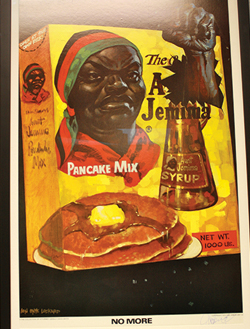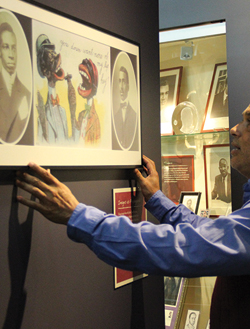Jim Crow Museum
1010 Campus Drive
Big Rapids, MI 49307
[email protected]
(231) 591-5873


Using Art To Fight RacismBlack artists have been at the forefront of the battle against anti-black imagery. They have used their art to "deconstruct" racist imagery. This painting was created by Michael Ray Charles. He suggests that there are similarities between the Sambo, Mammy, and minstrel images of the Jim Crow period and contemporary mass-media portrayals of black youths, celebrities, and athletes. While Charles notes that "stereotypes have evolved," he sees certain constants in the American subconscious. "I'm trying to deal with present and past stereotypes in the context of today's society." "Beware," by Michael Ray Charles |

Art as DiscontentLester White is a Grand Rapids-based artist whose portraits convey realistic drama. "Serving This" is White's deconstruction of Rastus, the Cream of Wheat chef. Rastus, like many Jim Crow Period pitchmen, was portrayed as a happy and smiling servant, content with his lowly status-wanting only to please the people he served. "Serving This," by Lester White. |

Art as ResistanceJon Onye Lockard is a painter, educator, and activist. He taught life drawing, portrait painting, and the art and culture of African Americans for more than forty years at the University of Michigan and at Washtenaw Community College. Known for his rich use of color and powerful use of form, Lockard's murals are located at Central State University, the University of Michigan, and Detroit's Charles H. Wright Museum of African American History. His painting "No More," a critique of commercial mammy imagery, was created in 1972. "No More," by Jon Onye Lockard. |

Images as PropagandaUsing images from the Jim Crow Museum, David Pilgrim creates collages and panels that remind viewers that the caricatured depictions of African Americans were deliberate attempts to distort the humanity of black people. "Styling," by David Pilgrim |